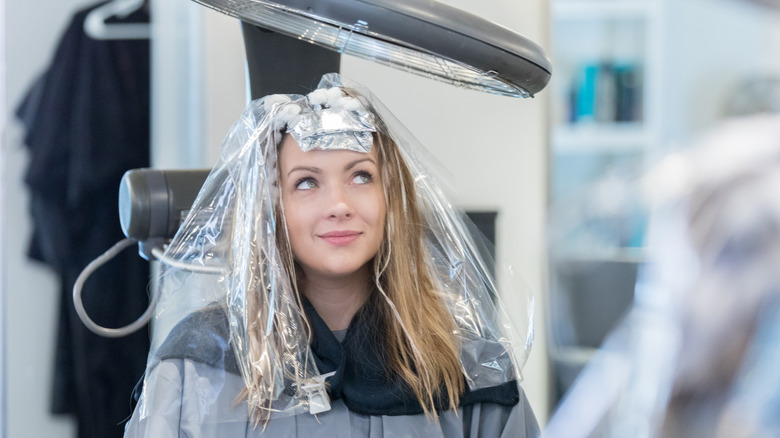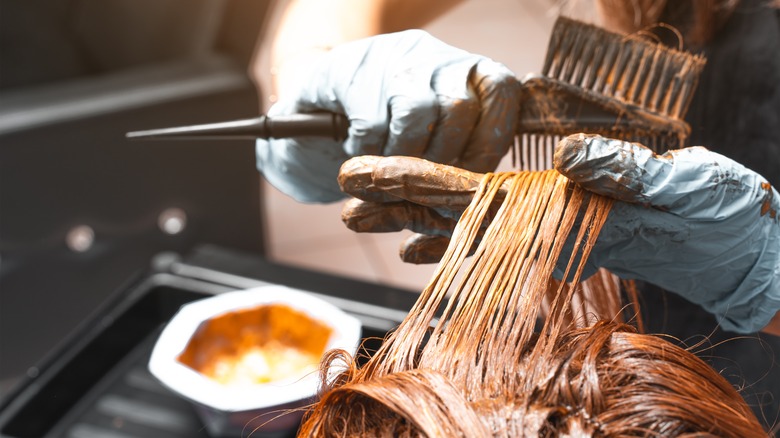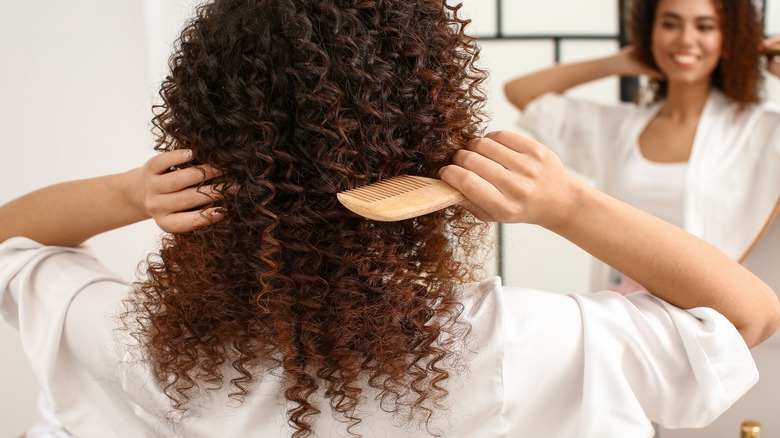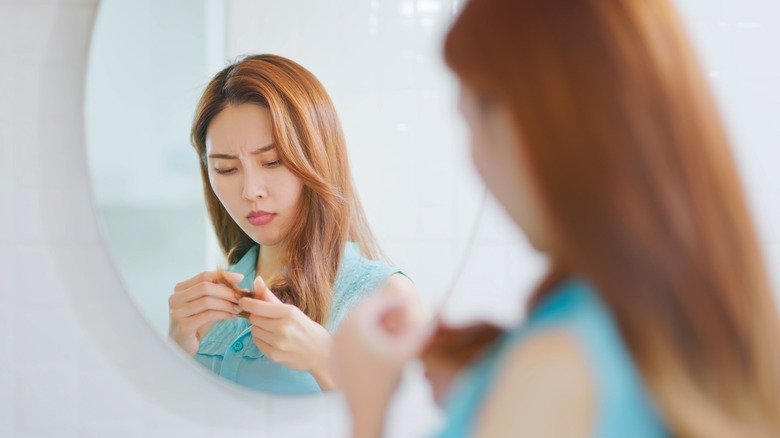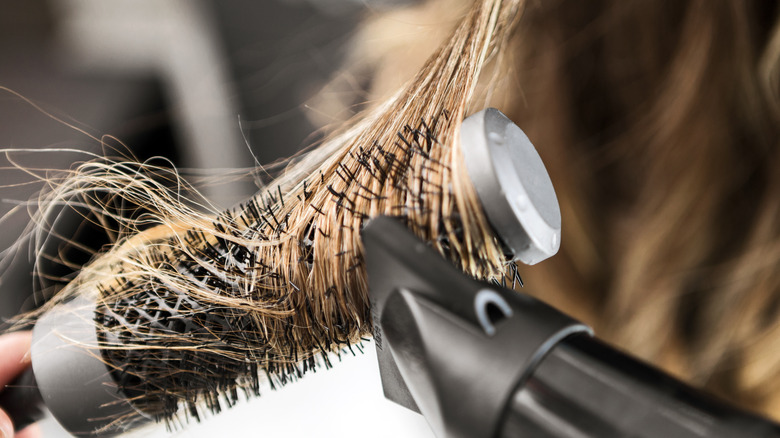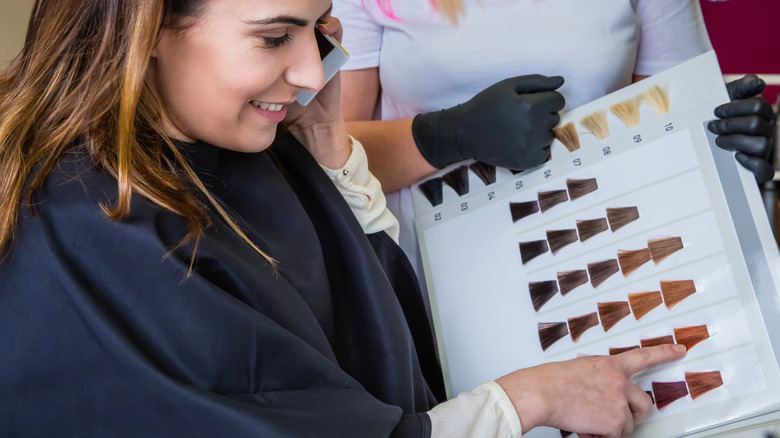Hair Glaze And Gloss: The Differences, Explained (Because They're Not Actually The Same)
If you've always been the type to opt for hair dye whenever you want to give yourself a fresh look, you know how much damage it can do — especially if you need to use bleach. While hair dye gives us the ability to show our true selves through color, it can put our tresses through the wringer. Regardless of how much prep we do, dye still impacts the proteins and lipids within our hair. This can ultimately weaken our strands, leaving them vulnerable to breakage.
Luckily, there is a wide range of precautionary measures we can take these days to minimize the damage caused by dye, bleaching, and other color-altering processes. In between your standard hair masks and leave-in conditioners, you may have heard of hair gloss and hair glaze while at the salon — but what are these increasingly common processes? "Generally speaking, a gloss and glaze are very similar," hair colorist Bianca Cox told The Zoe Report. "But there are areas where they differ, which is why consulting your stylist before making your appointment is important."
Hair gloss is considered to be a demi-permanent hair coloring technique by most experts. It is primarily used to color-correct existing dye in hair, but it can also simply refresh a hue. Similarly, hair glaze can enhance existing color. However, it can be less damaging to your tresses.
Could you use a boost from hair glaze?
If you're interested in giving the existing color in your locks a little boost, but you can't afford any damage, you may want to consider a hair glaze. Typically, you'll have the option to go with a clear glaze or a tinted one to add more dimension. Hair glaze is usually considered semi-permanent, and it can be used to repair any damage you may have or simply boost shine. If you've always struggled with dull tresses and over-the-counter shine-enhancing hair products aren't cutting it, now might be the time to speak to your colorist.
In the most basic sense, hair glaze can help your locks by serving as a glistening, transparent top coat. Once it's been applied, it will smooth any imperfections you may have within your hair shafts that are contributing to dullness. The top coat on your tresses can also protect them from further damage if you've already endured some as a result of dyeing or bleaching.
Because the top coat shields your hair once it's applied, it can extend the life of your existing color. This makes it a must for those who want to preserve their tone in between salon appointments. However, some who undergo the process don't see lasting results, which is something to keep in mind if you're expecting long-term results.
How you could benefit from hair gloss
Hair gloss has a few differences that separate it from hair glaze, and you'll want to familiarize yourself with them before you head to the salon. It's considered to be demi- or semi-permanent by most experts, similar to hair glaze. However, it's typically a process done at the salon, where a colorist can mix the chemicals. Hair gloss itself usually contains some ammonia or an ammonia substitute, and it's mixed with an activator prior to being applied to any hair, as noted by Oprah Daily. For this reason, it can be harsher on your tresses than a glaze, which does not contain ammonia. However, these chemicals are necessary to help the formula penetrate through your hair cuticles.
Hair gloss is also effective at closing your hair cuticles, resulting in smoother, shinier tresses. This process can ultimately strengthen your locks, which you may need if they're already damaged. It's best to speak to your stylist beforehand, however, to understand the potential risks and how it compares to hair glaze.
If you're looking to boost existing color or tone your tresses, hair gloss might also be more effective. Your colorist can add pigments to the mixture to achieve a specific tone while increasing the shine factor. Some people prefer this form of coloring to harsher, permanent dyes, but you'll want to weigh the pros and cons before making any decision.
What hair glaze and hair gloss can't do
Those who have used every type of dye to get the color they desire know that the process can begin to take its toll on tresses. Whether you visit your salon to have your hair professionally colored or do it in the comfort of your own home, the damage is undeniable. In addition to reducing the strength of your locks, dye can decrease thickness while increasing the roughness of follicles. This means that if you already struggle with dullness or thinning, dye can make these issues worse.
Because they don't include permanent dyes, hair gloss and glaze are sometimes viewed as healthier alternatives. However, there are some goals that can't be achieved with these semi-permanent processes. For example, toning pigments can be included in hair gloss, but they can't be used to lighten an existing color.
Similarly, hair glaze can't help you dramatically alter the existing color of your tresses. However, it can be applied to enhance the tone of highlights, for instance, if you're in between touch-up appointments. Don't forget about its shine-boosting benefits, too — they may not be long-lasting, but they can help you give your look the head-turning factor you desire. Best of all, you don't need to apply any abrasive chemicals to your tresses, and some glazes can be bought and used at home.
What to expect at a hair gloss appointment
If you decide to go forward with a hair gloss session at your salon, there are a few things you can expect. First, your colorist will likely ask you how you intend to shift the existing hue of your hair. Many people undergo the gloss process to subtly tone their hair, but some intend to alter its color to avoid having to use dye altogether. You might want to consider bringing a photo or two for your colorist to reference before you begin.
When you arrive, you'll have your hair washed with a pre-treatment to remove any product or residue from your tresses. After it's been towel-dried, the hair gloss will be applied when it's still damp. Usually, the application and treatment time lasts about 25 minutes before the colorist washes out the gloss. After your hair is blow-dried, you should immediately notice more shine and softness.
Generally speaking, hair gloss is best applied at a salon where a stylist can mix the chemicals and care for your tresses throughout the process. However, at-home hair gloss is a thing you may have seen at the store. "I absolutely do not advise doing glosses at home," hair colorist Matt Rez told Byrdie. "Any gloss that is mixed with a solution to process should be left to a pro, as they know how to formulate for desired results."
Is hair gloss or hair glaze better than dyeing?
If you aren't sure if you're ready to dye your hair (again) but you don't like the idea of hair gloss, hair glaze might be a better choice. Unlike gloss, there are many glazes that are safe to use at home, and they can be applied by almost anyone. If you've used a deep conditioner before, you may also be more comfortable using it, knowing that it works in a similar way — hair glaze can be used if you only want to tame fly-aways and frizz. You don't necessarily need to use it to enhance or alter an existing hair color. However, it can help seal in the hue and potentially extend its longevity.
The shine that comes with hair glaze is undeniable. That being said, its effects are relatively temporary, especially compared to hair gloss. A glaze can last up to one week, as it sits on top of the hair, rather than penetrating it. "The biggest differentiation between a gloss and a glaze is its lifespan," colorist Leland Hirsch told InStyle. "Glazes have no ammonia or peroxide, so will last in the hair up to one week, whereas a gloss can last up to four weeks."
It's best to talk to your stylist if you haven't tried either process. A professional can help you better understand the risks and benefits for your hair. They can also let you know which treatment will be best according to your needs.
